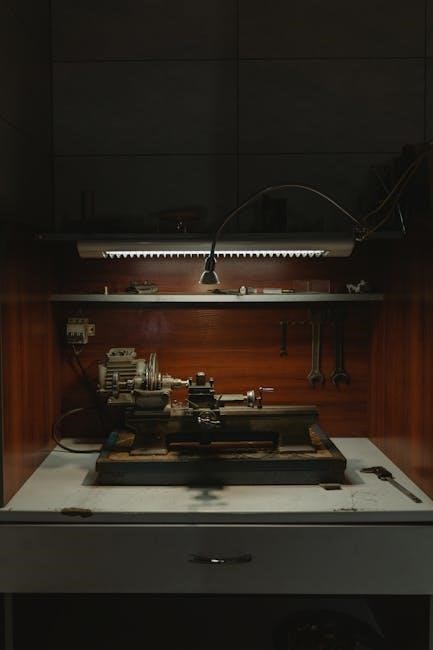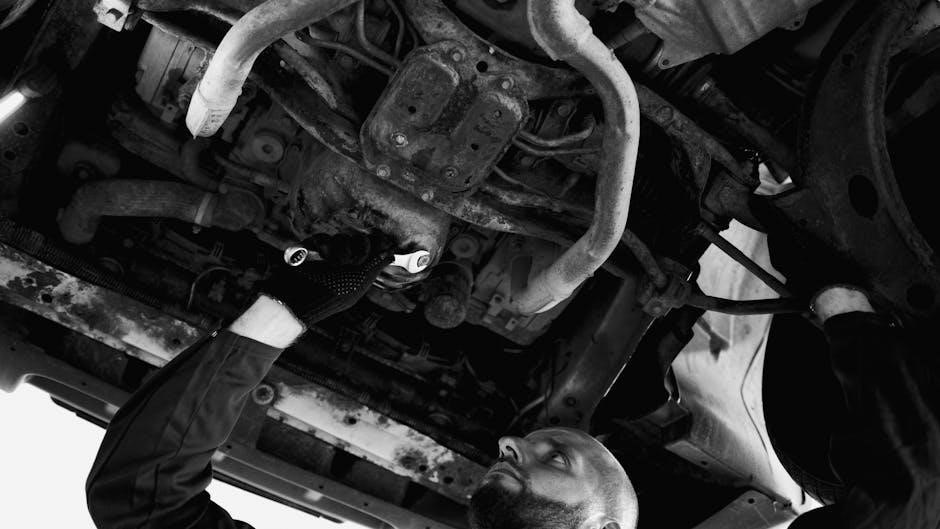Manually raising an inboard motor requires knowledge of trim and tilt systems‚ using the trim tab to adjust the motor’s position‚ and understanding the basics of hydraulic systems and engine housing.
Understanding the Basics of Trim and Tilt
To manually raise an inboard motor‚ it’s essential to understand the basics of trim and tilt systems‚ which are crucial for adjusting the motor’s position and ensuring optimal performance. The trim system allows for fine-tuning of the motor’s angle‚ while the tilt system enables the motor to be raised or lowered. Both systems work together to provide a smooth and efficient boating experience. By grasping the fundamental principles of trim and tilt‚ individuals can better comprehend the complexities of manually raising an inboard motor. This knowledge will also help in identifying potential issues and taking corrective measures to ensure the motor functions correctly. Furthermore‚ understanding trim and tilt systems will enable individuals to make informed decisions when maintaining or repairing their inboard motor. Proper use of these systems can also enhance the overall safety of the boat and its occupants.

Locating the Trim Motor and Associated Components
Identify the trim motor and components near the engine housing and transom using a visual inspection to locate the necessary parts and systems.
Identifying the Red Knob and Its Functionality
The red knob is a crucial component in the manual raising process of an inboard motor‚ typically located on the side of the bracket. It is essential to understand the functionality of the red knob‚ which is often mistakenly believed to allow manual trimming of the motor. However‚ the red knob may not move or function as expected‚ requiring further investigation to determine its purpose. According to various sources‚ the red knob may be related to the trim motor or hydraulic system‚ but its exact functionality can vary depending on the specific motor and system design. To properly identify and understand the red knob’s functionality‚ it is necessary to consult the motor’s manual or manufacturer’s instructions. By doing so‚ individuals can ensure safe and effective operation of the inboard motor. The red knob’s role is vital in the overall process.

Manually Raising the Motor Using the Trim Tab
Using the trim tab to manually raise the motor is a delicate process requiring careful adjustment and attention to detail always and every time slowly.
Turning Off the Engine and Accessing the Engine Housing
To begin the process of manually raising the motor‚ it is essential to turn off the engine and ensure it is in a safe state. This involves switching off the ignition and allowing the engine to cool down. Next‚ access the engine housing by locating the rear of the engine and the transom‚ which is the back edge of the boat. The engine housing is typically located in this area‚ and it may be necessary to remove some panels or covers to gain access. According to online forums‚ this step is crucial in preparing the motor for manual operation. By following these steps‚ you can safely and effectively access the engine housing and proceed with the manual raising process. The engine housing contains critical components that need to be adjusted or repaired.

Disconnecting the Metal Pins from the Trim Motor
Use an adjustable wrench to unscrew metal pins from the trim motor housing slowly.
Using an Adjustable Wrench to Unscrew the Pins
To manually raise the inboard motor‚ it is necessary to disconnect the metal pins from the trim motor‚ and this can be done by using an adjustable wrench to unscrew the pins. The adjustable wrench is a versatile tool that can be used to loosen a variety of fittings and fasteners‚ including the metal pins that connect the shaft to the trim motor. By turning the wrench counterclockwise‚ the pins can be slowly and carefully unscrewed‚ allowing the shaft-propeller to be raised manually. The process requires patience and attention to detail to avoid damaging the trim motor or other components. The adjustable wrench is an essential tool for this task‚ and it is widely available at most hardware stores and marine supply shops. The wrench should be used with care to avoid stripping the threads or damaging the pins.
Raising the Shaft-Propeller Manually
Manually raising the shaft-propeller requires careful preparation and attention to detail to avoid damage.
Preparing the Motor for Manual Operation
To prepare the motor for manual operation‚ it is essential to turn off the engine and ensure the area is clear of any obstacles. The engine housing should be accessed from the rear‚ and the back transom should be located. This is a crucial step in manually raising the motor‚ as it allows for the necessary adjustments to be made. The process requires attention to detail and careful planning to avoid any damage to the motor or surrounding components. By following the correct procedures‚ the motor can be safely and effectively prepared for manual operation. The use of an adjustable wrench may be necessary to unscrew certain pins‚ and the trim tab should be adjusted accordingly. This preparation is vital for a successful manual operation. The motor’s position and the hydraulic system’s status should be carefully considered;

Trimming the Drive for Optimal Performance
Adjusting the drive for optimal performance involves gradual trimming using the trim tab while monitoring the tachometer and speedometer readings carefully always.
Monitoring the Tachometer and Speedometer While Trimming
Monitoring the tachometer and speedometer while trimming is crucial for optimal performance‚ using the trim tab to adjust the motor’s position‚ and understanding the relationship between engine speed and boat speed. The tachometer measures engine revolutions per minute‚ while the speedometer measures the boat’s speed. By monitoring these gauges‚ you can determine the optimal trim setting for your boat‚ taking into account factors such as hull design‚ propeller pitch‚ and load. As you trim the drive‚ you will see the tachometer and speedometer readings change‚ indicating the effect of the trim adjustment on the boat’s performance. This information can be used to fine-tune the trim setting for optimal performance‚ ensuring a smooth and efficient ride. The process requires patience and attention to detail‚ but the results are well worth the effort‚ providing a better boating experience.
